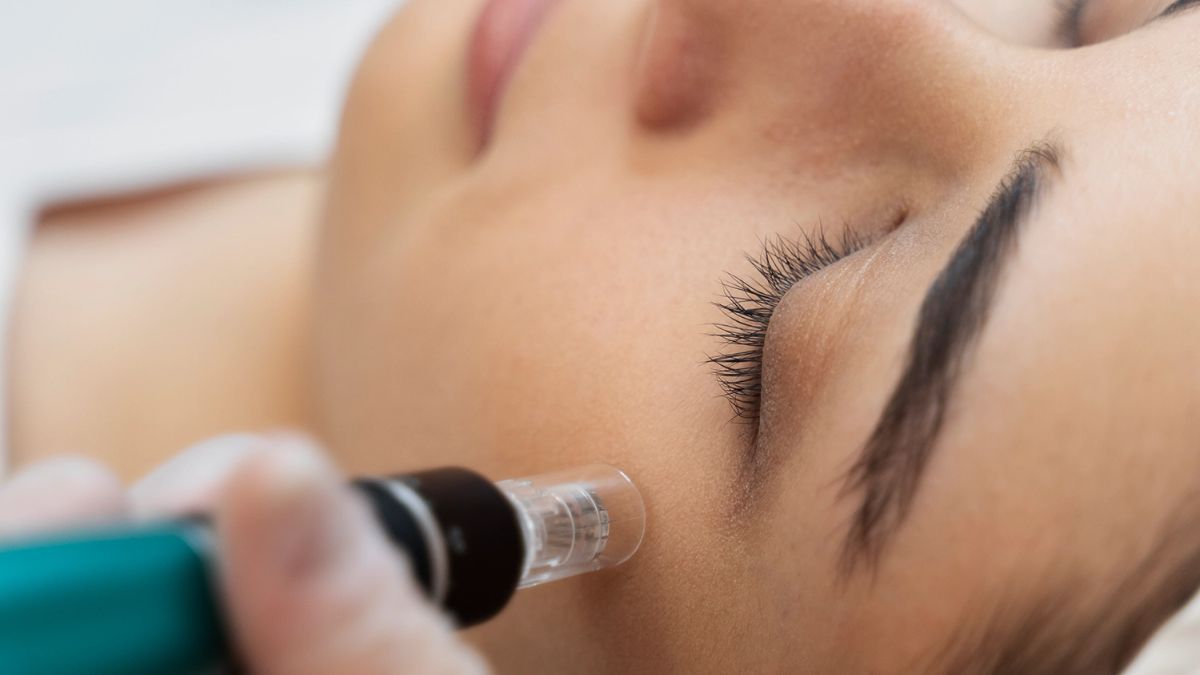What is Skin Needling?
Skin needling, often called microneedling or collagen induction therapy, is a minimally invasive skincare procedure that involves using tiny needles to create controlled micro-injuries on the skin’s surface. These microscopic punctures stimulate the skin’s natural healing process, promoting the production of collagen and elastin—the building blocks for youthful, radiant skin.
A Brief History of the Technique
Although microneedling may sound like a modern innovation, its roots trace back centuries. Ancient cultures used various forms of skin puncturing techniques for healing and rejuvenation. The modern version began to take shape in the late 20th century, with advancements in medical technology allowing for safer and more effective treatments.
Why It’s Gaining Popularity Today
In an age where people are more conscious than ever about aging and skin health, skin needling has surged in popularity. It offers a natural way to combat signs of aging, scarring, and pigmentation without the downtime or risks associated with more invasive cosmetic procedures like laser treatments or chemical peels.
The Science Behind Skin Needling
How Microneedling Works
When tiny needles puncture the skin, they trigger the body’s wound-healing mechanism. This controlled trauma prompts the skin to increase cell turnover and stimulates fibroblasts, the cells responsible for producing collagen and elastin. The result? New, fresh skin layers form, improving texture and elasticity.
The Role of Collagen and Elastin
Collagen provides structure and firmness to the skin, while elastin gives it the flexibility to bounce back. As we age, the natural production of these proteins slows, leading to wrinkles and sagging. Skin needling jumpstarts their production, helping skin regain its youthful resilience.
The Skin’s Natural Healing Response
The body’s healing response to micro-injuries is what makes microneedling so effective. By gently “tricking” your skin into thinking it’s been hurt, you promote the repair process that tightens and smooths skin, heals scars, and improves overall skin health.
Benefits of Skin Needling
Reducing Fine Lines and Wrinkles
One of the biggest draws of skin needling is its ability to soften fine lines and wrinkles. By encouraging collagen production, it helps plump up skin, reducing the appearance of these tell-tale signs of aging.
Treating Acne Scars and Hyperpigmentation
Skin needling can dramatically improve acne scars by breaking down old scar tissue and replacing it with fresh skin cells. It also helps balance skin tone by reducing hyperpigmentation and dark spots over time.
Improving Skin Texture and Tone
Uneven skin texture? Rough patches? Skin needling smooths the surface by boosting cell turnover, leading to a more even and radiant complexion.
Enhancing Product Absorption
Because microneedling creates microchannels in the skin, topical skincare products can penetrate deeper and work more effectively. This means your serums and creams deliver better results post-treatment.
Professional vs. At-Home Skin Needling
What to Expect from a Clinic Treatment
Professional treatments use longer needles and advanced devices, performed by licensed practitioners to target deeper skin layers safely. The results are often more dramatic, with customized treatment plans.
At-Home Derma Rollers: Are They Effective?
At-home rollers use shorter needles and are less invasive. They can be beneficial for mild skin concerns but won’t deliver the same depth or results as professional sessions.
Risks and Safety Tips
Improper use of at-home devices can cause irritation or infection. Always sanitize your tools, follow instructions, and avoid overuse. For serious skin issues, professional guidance is recommended.
Who Can Benefit from Skin Needling?
Suitable Skin Types and Conditions
Skin needling is generally safe for most skin types, including sensitive and darker skin tones. It’s particularly beneficial for those looking to reduce wrinkles, scars, large pores, and pigmentation.
Who Should Avoid It?
People with active skin infections, eczema, psoriasis, or those prone to keloid scarring should avoid microneedling. Pregnant women and those on certain medications should consult a doctor first.
How to Prepare for a Skin Needling Session
Pre-Treatment Do’s and Don’ts
Avoid sun exposure, retinol, and exfoliating products at least 48 hours before treatment. Stay hydrated and avoid alcohol or blood-thinning medications unless approved by your provider.
What to Bring and Expect
Wear comfortable clothing and come with a clean face, free from makeup. Your provider will explain the procedure and may apply a numbing cream to minimize discomfort.
Aftercare and Recovery
Immediate Post-Treatment Care
Your skin may appear red and feel warm, similar to a mild sunburn. Apply gentle moisturizers and sunscreen, and avoid makeup for at least 24 hours.
Common Side Effects and How to Handle Them
Mild swelling, peeling, or tenderness can occur but usually subside within a few days. Use soothing skincare products and avoid direct sun exposure.
Long-Term Skin Maintenance Tips
Maintain results with a balanced skincare routine rich in antioxidants, gentle exfoliation, and hydration. Follow up with periodic treatments as recommended.
How Often Should You Get Skin Needling Done
Recommended Frequency for Results
For noticeable improvements, treatments are usually spaced 4-6 weeks apart, with 3-6 sessions depending on individual goals.
How to Build It Into Your Routine
Combine microneedling with seasonal skincare updates and avoid overdoing it to allow skin ample time to heal.
Debunking Myths About Skin Needling
Does It Hurt?
Thanks to numbing creams and modern devices, discomfort is minimal and brief during professional treatments.
Will It Damage My Skin?
When done correctly, skin needling strengthens and renews skin rather than damaging it.
Is It Safe for Darker Skin Tones?
Unlike some laser treatments, microneedling is safe and effective across all skin tones, with a lower risk of pigmentation issues.
Choosing the Right Skin Needling Professional
Credentials to Look For
Seek licensed dermatologists, aestheticians, or skincare specialists with proven experience in microneedling.
Questions to Ask Before Booking
Inquire about their training, equipment used, expected results, and any potential risks.
Reading Reviews and Testimonials
Look for honest feedback from past clients to gauge satisfaction and safety.
Skin Needling Costs and Value
What Affects the Price?
Costs vary based on clinic location, practitioner expertise, treatment depth, and number of sessions.
Is It Worth the Investment?
For many, the natural, long-lasting results and minimal downtime make skin needling a highly cost-effective anti-aging solution.
Combining Skin Needling with Other Treatments
Skin Needling + PRP (Vampire Facial)
Adding platelet-rich plasma can boost healing and rejuvenation, making results even more impressive.
Skin Needling + Chemical Peels
Chemical peels and microneedling can complement each other but require careful timing to avoid irritation.
What to Avoid Post-Treatment
Stay away from harsh exfoliants, strong acids, and sun exposure immediately after treatment.
Real Results and Testimonials
Before and After Transformations
Many clients report visibly smoother, firmer, and brighter skin within weeks.
Personal Experiences from Real People
From battling acne scars to aging concerns, countless testimonials praise skin needling for its rejuvenating magic.
Conclusion
Skin needling unlocks a natural, effective pathway to youthful, radiant skin by tapping into the body’s own healing power. Whether you’re looking to soften wrinkles, smooth scars, or boost your glow, this minimally invasive treatment offers a safe and versatile option. With proper care, professional guidance, and patience, skin needling can truly transform your complexion and confidence.
FAQs
How long does it take to see results from skin needling?
Most people begin to notice improvements after 2-4 weeks, with full benefits developing over several months as collagen builds.
Can I wear makeup after a microneedling session?
It’s best to avoid makeup for at least 24 hours post-treatment to let your skin breathe and heal properly.
Is microneedling safe for sensitive skin?
Yes, but treatments should be customized and performed by experienced professionals to minimize irritation.
What’s the difference between microneedling and dermarolling?
Microneedling typically refers to professional treatments with motorized devices, while dermarolling usually involves manual rollers for at-home use.
Can skin needling help with stretch marks?
Yes, by stimulating collagen production, microneedling can reduce the appearance of stretch marks over time.


